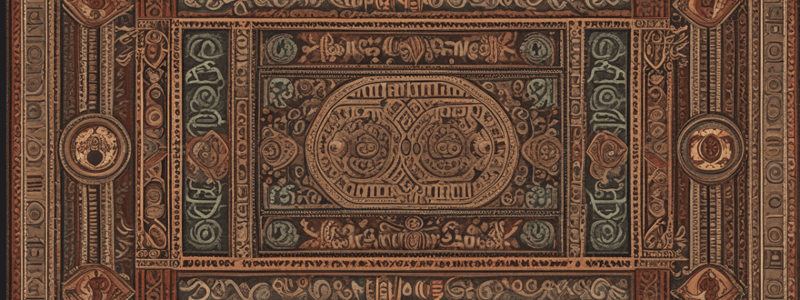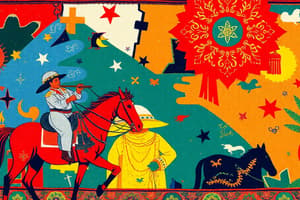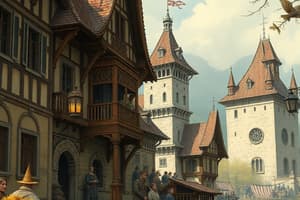Podcast
Questions and Answers
What is the field in the context of rug design?
What is the field in the context of rug design?
- The background of the rug inside the borders (correct)
- The widest decorative design around the outside of the rug
- The round, oval or polygonal design element at the center
- The narrow decorative designs flanking the main border
Which rug weaving method originated in Glasgow, Scotland?
Which rug weaving method originated in Glasgow, Scotland?
- Chenille (correct)
- Wilton Loom
- Hand Tufted
- Axminster
Which feature is the widest decorative design around the outside of the rug?
Which feature is the widest decorative design around the outside of the rug?
- Guard Borders
- Main Border (correct)
- Field
- Corner Brackets
Which hand-woven rug method uses a hooking tool?
Which hand-woven rug method uses a hooking tool?
What is the role of guard borders in rug design?
What is the role of guard borders in rug design?
Which of the following is NOT a machine-woven rug method?
Which of the following is NOT a machine-woven rug method?
Which design element sometimes occupies the center of the field?
Which design element sometimes occupies the center of the field?
What is done after the rug is taken off the loom in hand tufted method?
What is done after the rug is taken off the loom in hand tufted method?
When did the knotted pile carpet probably originate?
When did the knotted pile carpet probably originate?
What is the 'Pazyryk Carpet' framed by?
What is the 'Pazyryk Carpet' framed by?
According to purists, what makes an oriental rug antique?
According to purists, what makes an oriental rug antique?
Which part of a rug is made by wrapping yarn around several warps at the edge?
Which part of a rug is made by wrapping yarn around several warps at the edge?
What determines the utility value of an oriental rug?
What determines the utility value of an oriental rug?
Which part of a rug makes up its face?
Which part of a rug makes up its face?
What is the function of the wefts in a rug?
What is the function of the wefts in a rug?
Which material is easier to weave a flat, straight rug on?
Which material is easier to weave a flat, straight rug on?
What type of stitch is used in Needlework that is worked with wool yarns on a canvas mesh backing?
What type of stitch is used in Needlework that is worked with wool yarns on a canvas mesh backing?
Which type of rug is associated with a shaggy pile and fringed edges, originating from Morocco?
Which type of rug is associated with a shaggy pile and fringed edges, originating from Morocco?
Which type of rug is known for being very durable and features strong orange on red grounds?
Which type of rug is known for being very durable and features strong orange on red grounds?
Where were Savonnerie rugs originally produced?
Where were Savonnerie rugs originally produced?
Which type of rug features alternating short and long pile in abstract or contemporary peasant designs?
Which type of rug features alternating short and long pile in abstract or contemporary peasant designs?
What characterizes the construction of a hand-knotted rug?
What characterizes the construction of a hand-knotted rug?
What is a distinguishing feature of Persian knots?
What is a distinguishing feature of Persian knots?
What material is used to make Sisal rugs?
What material is used to make Sisal rugs?
What is a key characteristic of Turkish knots?
What is a key characteristic of Turkish knots?
How are flat weave rugs constructed?
How are flat weave rugs constructed?
Which type of rugs are most commonly woven in Turkey?
Which type of rugs are most commonly woven in Turkey?
What colors are commonly used in Kazakh geometric rugs?
What colors are commonly used in Kazakh geometric rugs?
Which of the following is an example of a flat weave rug?
Which of the following is an example of a flat weave rug?
What indicates that a rug is a floral rug?
What indicates that a rug is a floral rug?
Which of the following designs are typical for Indian decoration?
Which of the following designs are typical for Indian decoration?
Which design characteristics are associated with Turkomen rugs?
Which design characteristics are associated with Turkomen rugs?
What distinguishes Caucasian rug patterns?
What distinguishes Caucasian rug patterns?
Which of the following best describes Turkish rugs?
Which of the following best describes Turkish rugs?
Which characteristic is typical of Chinese rugs?
Which characteristic is typical of Chinese rugs?
What is a distinguishing feature of Alpujara rugs?
What is a distinguishing feature of Alpujara rugs?
Which of the following best describes Arraiolo rugs?
Which of the following best describes Arraiolo rugs?
Which characteristic is true about Dhurrie and Flokati rugs?
Which characteristic is true about Dhurrie and Flokati rugs?
What type of rug is known for using a repeating pattern of small motifs?
What type of rug is known for using a repeating pattern of small motifs?
Which district's design inspired the name Mir-Saraband?
Which district's design inspired the name Mir-Saraband?
What is a distinguishing feature of a Gabbeh rug?
What is a distinguishing feature of a Gabbeh rug?
Which type of Persian rug is known for its fine pile in dark reds and blues?
Which type of Persian rug is known for its fine pile in dark reds and blues?
Which rug typically features a camel's hair composition?
Which rug typically features a camel's hair composition?
What are Bijar rugs known for?
What are Bijar rugs known for?
Which rug design is characterized by a fine pile in soft cream and pastel colors?
Which rug design is characterized by a fine pile in soft cream and pastel colors?
What is the distinctive feature of Ispahan Herat rugs?
What is the distinctive feature of Ispahan Herat rugs?
What is the purpose of sizing in woven products?
What is the purpose of sizing in woven products?
What does shading in a carpet typically look like?
What does shading in a carpet typically look like?
Which term refers to patterns that match straight across in narrow width goods?
Which term refers to patterns that match straight across in narrow width goods?
What is a soil retardant finish used for in carpets?
What is a soil retardant finish used for in carpets?
Which of these is true about shading on carpets?
Which of these is true about shading on carpets?
When did Afghan rug-makers begin incorporating war apparatus into their designs?
When did Afghan rug-makers begin incorporating war apparatus into their designs?
What percentage of light output is directed downwards in a semi-direct lighting system?
What percentage of light output is directed downwards in a semi-direct lighting system?
Which lighting system distributes light upwards over the ceiling and upper wall?
Which lighting system distributes light upwards over the ceiling and upper wall?
Which method of light distribution directs approximately equal amounts of light upwards and downwards?
Which method of light distribution directs approximately equal amounts of light upwards and downwards?
What type of lighting is based in areas of total blackness for safety and comfort?
What type of lighting is based in areas of total blackness for safety and comfort?
Which light distribution method directs 90% to 100% of the light output downwards?
Which light distribution method directs 90% to 100% of the light output downwards?
What is the characteristic of valance lighting?
What is the characteristic of valance lighting?
What is ABRASH in the context of carpet?
What is ABRASH in the context of carpet?
What does the term 'HANDTUFTED' mean?
What does the term 'HANDTUFTED' mean?
Which term describes a carpet style with a level loop pile, often made of solution-dyed nylon?
Which term describes a carpet style with a level loop pile, often made of solution-dyed nylon?
What is a characteristic of ACRYLIC fiber?
What is a characteristic of ACRYLIC fiber?
What does 'DEAD DYEING' involve?
What does 'DEAD DYEING' involve?
Which term refers to a defect in a tufted carpet caused by a yarn wrapping around a needle during tufting?
Which term refers to a defect in a tufted carpet caused by a yarn wrapping around a needle during tufting?
What is the main purpose of CARPET CUSHION?
What is the main purpose of CARPET CUSHION?
What does DENSITY in carpets refer to?
What does DENSITY in carpets refer to?
Which fiber is most associated with the production of paper?
Which fiber is most associated with the production of paper?
What is the purpose of ADHESIVE in carpet installation?
What is the purpose of ADHESIVE in carpet installation?
What is the primary function of general lighting?
What is the primary function of general lighting?
Which type of lighting is used to enhance task performance by providing localized light?
Which type of lighting is used to enhance task performance by providing localized light?
How does the proper application of general lighting affect stress levels?
How does the proper application of general lighting affect stress levels?
Which type of lighting is primarily for aesthetic purposes and highlights specific objects?
Which type of lighting is primarily for aesthetic purposes and highlights specific objects?
What is the main difference between natural light and artificial light?
What is the main difference between natural light and artificial light?
What is the purpose of ambient light in general lighting?
What is the purpose of ambient light in general lighting?
Which type of lighting often depends on the position of furniture or activity areas?
Which type of lighting often depends on the position of furniture or activity areas?
What is one of the dangers associated with over-illumination in general lighting?
What is one of the dangers associated with over-illumination in general lighting?
What type of lighting should be used to provide a soft glow that blankets a space?
What type of lighting should be used to provide a soft glow that blankets a space?
Which kind of lighting creates pools of light mingled with areas of shadows?
Which kind of lighting creates pools of light mingled with areas of shadows?
Flashcards are hidden until you start studying
Study Notes
Materials of Decoration
Origin of Knotted Pile Carpet
- The knotted pile carpet probably originated in West Asia in the 3rd or 2nd millennium BC.
- There is evidence of goats and sheep being sheared for wool and hair as far back as the 7th millennium BC.
Classification of Oriental Rugs
- Antique: 100 years or more, made before 1856, and uses natural dyes.
- Semi-Antique or Old: between 50 and 100 years old.
- Utility Value: depends on the durability of the fabric as a floor covering.
- Art Value: depends on the color and design rather than the texture.
- Collectors' Value: depends on the rarity of the art value.
Parts of a Rug (Oriental)
- Warps: parallel strings stretched from loom beam to loom beam, upon which rows of knots are tied.
- Wefts: filling yarns that are woven through the warps, running across the width of the rug.
- Pile: the surface yarn that makes up the face of the rug.
- Knots: tied by looping yarn around pairs of warps and cutting off the standing end.
- Edge Bindings: made by wrapping several warps at the edge of the rug with yarn to reinforce this part.
- End Finishes: hold knots and wefts from working off the rug's warp strings.
Design Parts
- Field: the background of the rug inside the borders.
- Border: composed of decorative designs repeated in one direction around the outside of the rug.
- Main Border: the widest decorative design around the outside of the rug.
- Guard Borders: the narrow decorative designs flanking the main border.
- Medallion: the round, oval, or polygonal design element that sometimes occupies the center of the field.
- Corner Brackets or Spandrels: designs that sometimes fill the corners of the field.
Weaving Methods
- Machine Woven:
- Axminster
- Velvet
- Wilton Loom
- Chenille
- Hand Woven:
- Braided
- Crocheted
- Embroidered
- Hand Hooked
- Hand Tufted
Hand Knotted
- Each knot is individually tied by hand
- The knots are single strands of yarn
- Looped around two adjacent warp threads
- Known as the best kind of rug construction
Persian Knot
- Invented by the Persians
- A short piece of thread is laid across the warps
- The other end passes down between the two warp threads and up outside
- Also called a Sehna/Senneh knot
Turkish Knot
- A symmetrical structure
- A short piece of thread is laid across two warps
- The ends are carried down outside and up between them and pulled tight
- Also sometimes called a Ghiordes knot
Flat Weave
- A rug type that is woven without knots
- It is constructed without a pile
- Colored weft yarns are woven through the warps
- Used to create the pattern
Classification of Oriental Rugs by Pattern Type
- Geometric Rugs: mostly made by tribal and primitive village people
- Floral Rugs: made by educated urban people
Geometric Rugs
- Kazakh: woven with sharp reds, blues, and off-whites
- Bachtiari: bright yellows, greens, and reds predominate
- Boukara: woven rugs are usually in some shade of red
Floral Rugs
- Made by educated urban people
- Intricate flowing patterns indicate a sophisticated lifestyle
- Named after cities that had been capital
Classification of Oriental Rugs by Geographic Origin
- Persian: generally have a delicately colored all-over pattern of flowers, vines, and leaves
- Saraband: entire field covered with a repeating pattern of palm leaves
- Ispahan: coarse pile weaving, intricately done, and stately design on claret ground
- Hamadan: camel's hair rug with a coarse weave in light browns, reds, and blues
- Kerman: fine pile in soft cream, rose, light blue, and other pastel colors
Other Types of Rugs
- Indian: decorated with motifs of flowers, vines, and animals
- Turkomen: mostly woven with contrasting, shrimp-like pile, predominantly red
- Caucasian: similar patterns to Persian, but with smaller patterns and different color schemes
- Turkish: sometimes called Asia Minor weavings and are woven in both geometric and floral designs
- Chinese: recognizable by their soft ground colors of yellow, rose, salmon red, beige, and brown
- Alpujara: colorful hand-woven rugs with tree of life patterns
- Arraiolo: Portuguese hand-embroidered accent rugs
- Aubusson: named for the French town of Aubusson, where it was made
- Braided: hand-made by Americans in the late 18th Century
- Dhurrie: shaggy wool area rugs made in Greece
- Flokati: shaggy wool area rugs made in Morocco
- Needlework: tapestry-stitch embroidery worked with wool yarns on a canvas mesh backing
Glossary of Terms for Carpet
- Abrash: variation of color in a rug
- Acrylic: a manufactured fiber of moderate cost, good durability, and easy-care properties
- Adhesive: a substance that will adhere to a surface and to itself to bind one material to another### Textile Terminology
- Sizing is a coating applied to the back of woven products to enhance stiffness and reduce raveling.
- Soil retardant is a chemical finish applied to fibers of carpet surfaces that inhibits attachment of soil.
- War rug is an Afghanistan rug that originated during the Soviet occupation of Afghanistan, featuring designs that incorporate war apparatus.
Illumination and Lighting
- Illumination is the deliberate use of light to achieve a practical or aesthetic effect.
- It includes the use of both natural and artificial light sources.
- Proper lighting can enhance task performance, improve the appearance of an area, or have positive psychological effects on occupants.
Sources of Light
- Natural light is achieved through windows, skylights, or light shelves, and can save energy by using natural light instead of artificial lighting.
- Artificial light is light from electrical sources, which can be turned on and off at a switch.
Classification of Lighting
- General lighting, also known as background or ambient lighting, provides a uniform level of illumination for a general level of visibility.
- It gives a soft glow that blankets the space, making it safe and easy to navigate.
- Over-illumination can cause tiredness and anxiety, while incorrect application can cause stress.
- Local lighting provides a high level of illumination over a small area, with a surrounding area of lower intensity.
- Task lighting is intended for specific tasks, providing localized light in certain areas where work is typically done.
- Accent lighting reveals color, texture, and form, and is used to create a visual accent.
- Information lighting provides visual information for our safety and comfort.
Methods of Light Distribution
- Indirect lighting directs 90% to 100% of light output towards the ceiling and upper walls.
- Semi-indirect lighting directs 60% to 90% of light upwards, 40% to 10% downwards.
- Direct-indirect lighting provides approximately equal distribution of light upwards and downwards.
- Semi-direct lighting directs 60% to 90% of light downwards, while 40% to 10% is directed upwards.
- Direct lighting directs 90% to 100% of light output downwards.
- General lighting distributes light on all sides.
Lighting Systems
- Cornice lighting is a system where light sources are shielded by a panel parallel to the wall and attached to the ceiling to distribute light downwards over the wall.
- Cove lighting is a system where light sources are shielded by a ledge to distribute light upwards over the ceiling and upper wall.
- Valance lighting is a system where light sources are shielded by a panel parallel to the wall, usually across the top of a window, providing light both upwards and downwards over the wall.
Studying That Suits You
Use AI to generate personalized quizzes and flashcards to suit your learning preferences.




